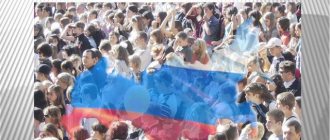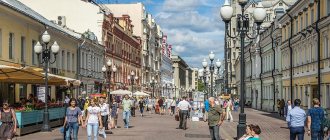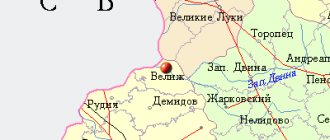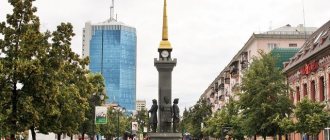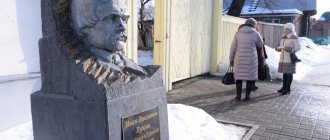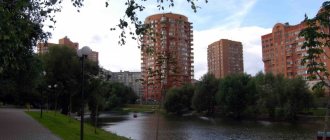City in Moscow region, Russia
| Bronnitsy Bronnitsy | |
| Town[1] | |
| Flag Coat of arms | |
| Location of Bronnitsy | |
| Bronnitsy Location of Bronnitsy Show map of Russia Bronnitsy Bronnitsy (Moscow region) Show map of the Moscow region | |
| Coordinates: 55°25′34″N 38°15′54″E / 55.42611°N 38.26500°E / 55.42611; 38.26500Coordinates: 55 ° 25′34″ N 38°15′54″E / 55.42611°N 38.26500°E / 55.42611; 38.26500 | |
| A country | Russia |
| Federal subject | Moscow region[1] |
| Known since | 1453[2] |
| City status from | 1780s |
| Government | |
| • Mayor | Victor Nevolin |
| Height | 120 m (390 ft) |
| population (2010 Census)[3] | |
| • General | 21,102 |
| • Evaluate (2018)[4] | 22,567 (+6.9%) |
| Administrative status | |
| • Subordinate | Bronnitsy City of regional subordination[1] |
| • Capital from | City of Bronnitsy of regional subordination[1] |
| Municipal status | |
| • Urban district | Bronnitsy urban district[5] |
| • Capital from | Bronnitsy urban district[5] |
| Timezone | UTC + 3 (MSK [6]) |
| Postal code(s)[7] | 140170 |
| Dial code(s) | +7 49646 |
| OKTMO I WOULD | 46705000001 |
| Web site | bronnitsy.RU |
Bronnitsy
(Russian: Bronnitsy) is a town in Moscow Oblast, Russia, located 54.5 km (33.9 mi) southeast of central Moscow and 13 km west of Bronnitsy station on the Moscow Highway. Ryazan Railway. The city is surrounded by the Ramensky district but is administratively registered as a city of regional subordination. Population: 21,102 (2010 Census).[3]
The local economy relies on food processing and packaging, construction services and decoration manufacturing. Bronnitsy was one of the twenty-two historical cities of the Moscow region.[8]
The existence of Bronnitsy has been attested since 1453. The village originated as a stop on the Moscow-Ryazan highway (now the M5 Road), and its population and economy traditionally supported horses. In the House of Romanov, the stables, founded in Bronnitsy by 1634, turned into horse farms supplying horseback riding to the cavalry. In the 1780s, Catherine the Great's administrative reforms transformed the village into a proper town with a grid plan and a growing trading community.[ citation needed
] In the second half of the 19th century, Bronnitsy gradually industrialized, turning into a city of small textile factories and jewelers.
Bronnitsy played a minor role in the military history of the Time of Troubles and Napoleonic invasion of Russia, when it became the furthest point of the French advance after the fall of Moscow, but was spared military action and destruction. Its key landmarks are the five-domed Cathedral of the Archangel Michael (completed 1705), the Church of the Entry into Jerusalem (1845), and the neoclassical cavalry barracks.[9]
Etymology
Toponyms starting from Bron-
(plural
Bronnitsy
,
Broniki
; singular
Bronnikovo
,
Brontsa
, etc.) are common to all East Slavic territories, starting from Bronitsa in the Lviv region from Ukraine[10] to Bronnikovo in the Chita region of Russia. Each of these towns and villages has a different etymology behind its name. In the case of Bronnitsy of the Moscow region, all proposed versions were disputed, and none of them received the firm preference of historians.[11]
- The most popular version gets Bronnitsy
from
bronze
(modern Russian: armor, armor), suggesting that Bronnitsy was a village of gunsmiths. This version, however, contradicts the history of medieval Bronnitsy.[11][12] - Distantly related explanations suggest the existence of a notable warrior
or man named Bronislaw.[11] - Another explanation connects the Bronnitsy
to
bran'
(swearing,
fighting
or
combat
), referring to the fight with the Tatars.[13] - The most plausible version derives Bronnitsy
from the obsolete
bronk
, the word originally meant
oat thorns
, later ears of any cultivated porridge.
Bronnitsy originated as a pit station on the highway, and its granaries were needed to feed the horses with sweet potatoes. Bronnitsy
, presumably, are feeders located along the route.[11]
The latter version is supported by the fact that another, older village, once called Bronnitsy, now Bronnitsy on the Msta R., also turned into a sweet potato production station.[14]
Geography
The historical center of Bronnitsy stands on the southern shore of the narrow and shallow Lake Belskoye, the former Moscow-River trail that is now completely cut off from the river. The narrow and flat area between the lake and the river is partly occupied by fifteen football fields and an Olympic reserve school specializing in training. rowing athletes; The lake itself serves as a rowing channel. Two small islands on the lake are uninhabited, the lake itself is bridged by pedestrians. suspension bridge.
The Moscow-Ryazan road, which once passed through Bronnitsy, now skirts the city center north of Ring Road A-107 and returns to the old track south of it. Sovetskaya Street, a section of the M5 highway passing through Bronnitsy, is still an important street passing through the city center. A-107, a major east-west corridor, crosses the city and the Moscow River a few blocks south of Lake Belskoye. The old and narrow bridge over the Moscow River causes queues that sometimes reach 10 kilometers (6.2 miles).[15] In August 2008, the poor condition of the bridge due to its heavy use led to a ban on trucks and buses on the bridge, further worsening congestion.[16] A year later, the city administration agreed to begin construction of a second two-lane bridge next to the old one, but funds have not yet been firmly allocated.[17]
Traditional single-family homes remain throughout much of the city. Mid-rise buildings are concentrated in the southern part of Bronnitsy along the A-107 highway.
Excerpt characterizing Bronnitsy
Pierre gradually began to come to his senses and look around the room where he was and the people in it. Around a long table covered in black sat about twelve people, all in the same clothes as those he had seen before. Pierre knew some of them from St. Petersburg society. An unfamiliar young man sat in the chair, wearing a special cross around his neck. On the right hand sat the Italian abbot, whom Pierre had seen two years ago at Anna Pavlovna's. There was also one very important dignitary and a Swiss tutor who had previously lived with the Kuragins. Everyone was solemnly silent, listening to the words of the chairman, who was holding a hammer in his hand. There was a burning star embedded in the wall; on one side of the table there was a small carpet with various images, on the other there was something like an altar with a Gospel and a skull. Around the table there were 7 large, church-like candlesticks. Two of the brothers brought Pierre to the altar, put his legs in a rectangular position and ordered him to lie down, saying that he was throwing himself towards the gates of the temple. “He must get a shovel first,” one of the brothers said in a whisper. - A! completeness please,” said another. Pierre, with confused, myopic eyes, disobeying, looked around him, and suddenly doubt came over him. "Where I am? What am I doing? Are they laughing at me? Will I be ashamed to remember this? But this doubt lasted only for an instant. Pierre looked back at the serious faces of the people around him, remembered everything he had already gone through, and realized that he could not stop halfway. He was horrified by his doubt and, trying to evoke in himself the former feeling of tenderness, he threw himself towards the gates of the temple. And indeed a feeling of tenderness, even stronger than before, came over him. When he had been lying there for some time, they told him to get up and put on him the same white leather apron that the others were wearing, they gave him a shovel and three pairs of gloves, and then the great master turned to him. He told him to try not to stain the whiteness of this apron, which represents strength and purity; then about the unknown shovel he said that he should work with it to cleanse his heart from vices and condescendingly smooth over the heart of his neighbor with it. Then about the first men’s gloves he said that he could not know their meaning, but must keep them, about other men’s gloves he said that he should wear them in meetings, and finally about the third women’s gloves he said: “Dear brother, and these women’s gloves are for you.” the essence is determined. Give them to the woman you will honor the most. With this gift, assure the one whom you choose as a worthy stonemason of the integrity of your heart.” And after being silent for a while, he added: “But be careful, dear brother, that these gloves are not adorned by unclean hands.” While the great master uttered these last words, it seemed to Pierre that the chairman was embarrassed. Pierre became even more embarrassed, blushed to the point of tears, like children blush, began to look around restlessly, and an awkward silence ensued. This silence was interrupted by one of the brothers, who, leading Pierre to the carpet, began to read from a notebook an explanation of all the figures depicted on it: the sun, the moon, the hammer. a plumb line, a shovel, a wild and cubic stone, a pillar, three windows, etc. Then Pierre was assigned his place, they showed him the signs of the box, said the opening word and finally allowed him to sit down. The Great Master began to read the charter. The charter was very long, and Pierre, from joy, excitement and shame, was not able to understand what was being read. He listened only to the last words of the charter, which he remembered. “In our temples we do not know other degrees,” the great master read, “except those that are between virtue and vice. Beware of making any distinction that might violate equality. Fly to the aid of your brother, no matter who he is, guide the erring one, lift up the falling one, and never harbor anger or enmity against your brother. Be kind and friendly. Stir up the fire of virtue in all hearts. Share your happiness with your neighbor, and may envy never disturb this pure pleasure. Forgive your enemy, do not take revenge on him, except by doing him good. Having thus fulfilled the highest law, you will find traces of the ancient majesty you have lost.” He finished and, standing up, hugged Pierre and kissed him. Pierre, with tears of joy in his eyes, looked around him, not knowing how to respond to the congratulations and renewal of acquaintances with whom he was surrounded. He did not recognize any acquaintances; in all these people he saw only brothers with whom he was eager to get down to business. The great master slammed his hammer, everyone sat down, and one read a lesson on the need for humility. The great master offered to perform the last duty, and an important dignitary, who bore the title of alms collector, began to make the rounds of the brothers. Pierre wanted to write down all the money he had on the alms sheet, but he was afraid to show pride by doing so, and he wrote down the same amount as others wrote down. The meeting was over, and upon returning home, it seemed to Pierre that he had come from some long journey, where he had spent dozens of years, had completely changed and fell behind the previous order and habits of life. The next day after being admitted to the lodge, Pierre sat at home, reading a book and trying to understand the meaning of the square, which depicted God on one side, moral on the other, physical on the third, and mixed on the fourth. From time to time he looked up from the book and the square and in his imagination made up a new life plan for himself. Yesterday in the box he was told that a rumor about a duel had reached the sovereign's attention, and that it would be more prudent for Pierre to leave St. Petersburg. Pierre intended to go to his southern estates and take care of his peasants there. He was joyfully pondering this new life when Prince Vasily suddenly entered the room. – My friend, what have you done in Moscow? Why did you quarrel with Lelya, mon сher? [my dear?] “You are mistaken,” said Prince Vasily, entering the room. “I found out everything, I can tell you correctly that Helen is innocent before you, like Christ before the Jews.” - Pierre wanted to answer, but he interrupted him. “And why didn’t you address me directly and simply as a friend?” “I know everything, I understand everything,” he said, “you behaved as befits a person who values his honor; It may be too hasty, but we won’t judge that. Just remember the position in which you place her and me in the eyes of the whole society and even the court,” he added, lowering his voice. – She lives in Moscow, you are here. Remember, my dear,” he pulled him down by the hand, “there is one misunderstanding here; I think you feel it yourself. Write a letter with me now, and she will come here, everything will be explained, otherwise I’ll tell you, you can get hurt very easily, my dear. Prince Vasily looked at Pierre impressively. “I know from good sources that the Empress Dowager takes a keen interest in this whole matter.” You know, she is very merciful to Helen. Several times Pierre was going to speak, but on the one hand, Prince Vasily did not allow him to do so, on the other hand, Pierre himself was afraid to start speaking in that tone of decisive refusal and disagreement in which he firmly decided to answer his father-in-law. In addition, the words of the Masonic charter: “be kind and friendly” came to his mind. He winced, blushed, stood up and fell down, working on himself in the most difficult task in his life - to say something unpleasant to a person’s face, to say something that was not what this person, no matter who he was, expected. He was so accustomed to obeying this tone of Prince Vasily’s careless self-confidence that even now he felt that he would not be able to resist it; but he felt that his entire future fate would depend on what he said now: whether he would follow the old, former road, or along that new one, which was so attractively shown to him by the Masons, and on which he firmly believed that will find rebirth to a new life. “Well, my dear,” said Prince Vasily jokingly, “tell me: “yes,” and I will write to her on my own behalf, and we will kill the fat calf.” - But Prince Vasily did not have time to finish his joke, when Pierre, with a fury in his face that reminded him of his father, without looking into the eyes of his interlocutor, said in a whisper: - Prince, I did not invite you to my place, go, please, go! “He jumped up and opened the door for him. “Go,” he repeated, not believing himself and rejoicing at the expression of embarrassment and fear that appeared on Prince Vasily’s face. - What happened to you? You are sick? - Go! – the trembling voice spoke again. And Prince Vasily had to leave without receiving any explanation. A week later, Pierre, having said goodbye to his new friends, the Freemasons, and leaving them large sums of alms, left for his estates. His new brothers gave him letters to Kyiv and Odessa, to the Freemasons there, and promised to write to him and guide him in his new activities. The affair between Pierre and Dolokhov was hushed up, and, despite the sovereign’s then strictness regarding duels, neither both opponents nor their seconds were harmed. But the story of the duel, confirmed by Pierre’s breakup with his wife, became public in society. Pierre, who was looked upon condescendingly and patronizingly when he was an illegitimate son, who was caressed and glorified when he was the best groom of the Russian Empire, after his marriage, when brides and mothers had nothing to expect from him, lost greatly in the opinion of society, especially that he did not know how and did not want to curry public favor. Now he alone was blamed for what had happened, they said that he was a stupid jealous person, subject to the same fits of bloodthirsty rage as his father. And when, after Pierre’s departure, Helen returned to St. Petersburg, she was not only cordially, but with a touch of respect for her misfortune, received by all her acquaintances. When the conversation turned to her husband, Helen adopted a dignified expression, which she, although not understanding its meaning, with her characteristic tact, adopted for herself. This expression said that she decided to endure her misfortune without complaining, and that her husband was a cross sent to her from God. Prince Vasily expressed his opinion more openly. He shrugged his shoulders when the conversation turned to Pierre, and, pointing to his forehead, said: “Un cerveau fele – je le disais toujours.” [Half-crazy - I always said that.] “I said in advance,” Anna Pavlovna said about Pierre, “I said right then, and before everyone else (she insisted on her primacy), that this is a crazy young man, spoiled by the depraved ideas of the century. I said this back then, when everyone admired him and he had just arrived from abroad, and remember, one evening I thought he was some kind of Marat. How did it end? I didn’t want this wedding then and predicted everything that would happen. Anna Pavlovna continued to host such evenings on her free days as before, and those that she alone had the gift of arranging, evenings at which she gathered, firstly, la creme de la veritable bonne societe, la fine fleur de l' essence intellectuelle de la societe de Petersbourg, [the cream of a truly good society, the color of the intellectual essence of St. Petersburg society,] as Anna Pavlovna herself said. In addition to this refined choice of society, Anna Pavlovna’s evenings were also distinguished by the fact that every time at her evening Anna Pavlovna presented her society with some new, interesting face, and that nowhere, as at these evenings, was the degree of the political thermometer expressed so clearly and firmly, on which the mood of the court legitimist St. Petersburg society stood. At the end of 1806, when all the sad details had already been received about Napoleon’s destruction of the Prussian army near Jena and Auerstätt and about the surrender of most of the Prussian fortresses, when our troops had already entered Prussia, and our second war with Napoleon began, Anna Pavlovna gathered at her place evening. La creme de la veritable bonne societe [The cream of real good society] consisted of the charming and unhappy Helene, abandoned by her husband, from MorteMariet, the charming Prince Hippolyte, who had just arrived from Vienna, two diplomats, an aunt, one young man who enjoyed living room with the name simply d'un homme de beaucoup de merite, [a very worthy person], one newly granted maid of honor with his mother and some other less noticeable persons. The person with whom Anna Pavlovna treated her guests like a novelty that evening was Boris Drubetskoy, who had just arrived as a courier from the Prussian army and was an aide-de-camp to a very important person.
Story
Cathedral Square with a 73-meter bell tower
Rurikovich and early Romanovs (1453–1780)
Bronnitsy is first mentioned as Bronnishe
(Bronniche) in the will of 1453 Sophia of Lithuania; bequeathed Bronnitsy and other villages of her possession around Kolomna to her grandson Yuri.[18] The wars of the 15th and 16th centuries spared the village; The first, albeit minor, hostilities took place during the Time of Troubles. In 1606, the troops of Prince Vasily Mosalsky entered into battle against the Ivan Bolotnikov rebels, three miles from Bronnitsy.[18] In 1618, Hetman Peter Konashevich-Sagaidachny, acting in accordance with Vladislav IV Vasa, stopped in Bronnitsy on his way from Serpukhov to Moscow.[18]
Mikhail Romanov owned Bronnitsy as a private property and kept the royal stables there, which housed up to 190 horses (the first written evidence of the existence of royal stables in Bronnitsy dates back to 1634).[19]The Romanovs of the 17th century preserved Bronnitsy only as a household item.[19] The village developed in relative prosperity, as evidenced by the construction of the Cathedral of the Archangel Michael, begun in the 1690s and completed in 1705.[18]Peter the Great converted it into a productive stud farm.[19] He granted Bronnitsy to Alexander Menshikov;[11] after his fall in 1727, control over the village and state stud farms passed to the statesman Pavel Yaguzhinsky, who “brought” the matter to ruin.[20] The statesman Artemy Volynsky, Yaguzhinsky's nemesis, took control of the stud farms in 1733. Business was slow to recover; By the time of Volynsky's treason trial in 1740, the farm in Bronnitsy had 221 horses and specialized in breeding. horse riding.[19] The next manager, Alexander Kurakin, increased the number of horses to 277 in less than ten years.[19]
The microhistory of the Bronnitsy of that period, despite significant surviving archives, has not yet been properly collated and published. The daily life of the city in the 17th and 18th centuries remains largely unknown, apart from a few unusual events that attracted the attention of the imperial government. For example, when nearby Kolomna was struck by the plague of 1770–1772, Bronnitsy priests refused to respect the quarantine imposed by civil authorities and continued to organize potentially dangerous mass processions. The Holy Synod had to put pressure on Archbishop Theodosius, who, in turn, personally forced the priests to obey.[21]
Growth and French invasion
Alexander Pushkin (the poet's son), depicted here as an old man, carried out peasant reform in Bronnitsy when he was over thirty.
In 1781, Bronnitsy, which then had a population of five hundred people, became the administrative center of the district of the Moscow province.[18]Catherine the Great granted the former village a city charter and the coat of arms of a Golden horse on a green field - a tribute to the Bronnitsy stud farms.[18] The influx of petty bureaucrats led to a significant increase in population and the construction of the first public buildings; a new grid plan was approved in 1784 and by 1787 the population had tripled.[18] Until the mid-19th century it was about 1,500 people.[22]
In September 1812, Bronnitsy and Bogorodsk became the furthest points reached by French troops in Napoleonic invasion of Russia. After the surrender of Moscow on September 14, the main Russian army retreated to the southeast along the river. Ryazan is a road, “carefully”[23] in the shadow of the Murat Cavalry. On September 17, Kutuzov made a sharp turn west to Podolsk; a small task force continued to move towards Ryazan, posing as the entire army. Murat missed Kutuzov's move and did not discover the deception until he reached Bronnitsy. Although Napoleon became suspicious of a Russian maneuver by 21 September,[24] the French lost the Russian army for two days[25] and fought a wide pursuit that ended at the Battle of Tarutino.[26] Murat's raid, accompanied by inevitable looting and fires, was the last foreign invasion of Bronnitsy in history (the city was spared during World War II).[18]
After the War of 1812, Bronnitsy gradually turned into a typical small trading town and served as the base of a cavalry regiment; the former cavalry barracks, built in the Empire style, are attributed to either Vasily Stasov[9] or Alexander Kutepov.[27] The Rotunda of Jerusalem Church, standing near the Cathedral of the Archangel Michael, was built in the 1840s by Alexander Shestakov in the late neoclassical style.[13 ] Its pseudo-Russian red brick bell tower was erected in the 1850s in clear contrast to historical churches.[28] These landmarks have survived despite several extensive fires; The worst recorded fire in 1861 destroyed 115 houses.[18] Another major fire occurred in 1863, but despite the destruction, one hotel, two bars and 118 retail outlets remained in Bronnitsy; two hundred families had trade patents[18] but the city's finances were poor and it could not even pay for the paving of the unbearably impassable main square.[19]
In the 1850s and 1860s Bronnitsy became home to prominent members of the parish's decline. Russian nobility. Decembrist Mikhail Fonvizin (1787–1854) and his wife Natalya, a local landowner, left for Bronnitsy after exile in Siberia.[13] Fonvizin died soon after his return; the widow married another Decembrist, Ivan Pushchin (1798–1859).[13] Both Fonvizin and Pushchin were buried near the Archangel Cathedral.[13] Retired army colonel Alexander Pushkin (1833–1914), son of the poet. Alexander Pushkin, served as a magistrate in Bronnitsy in 1862–1866, administering the Liberation Reform of 1861.[29] His son, also Alexander Pushkin (1863–1916), born in Bronnitsy, became a judge of the Bronnitsy district (Russian: Zemsky chief) in 1890, and from 1897 the zemstvo of the city and country.[18]
Industrialization
Main street Bronnitsy, old Moscow-Ryazan highway
The railway boom of the 1860s bypassed Bronnitsy: the Bronnitsy railway station of the same name, operating since 1864, was actually built 12 versts (13 km) from the city center,[11] on the opposite bank of the river. The dam and bridge over the river were built by local contractor Smorchkov in 1872.[30] Residents happily left Bronnitsy for industrial and service work in Moscow: by 1882, Bronnitsky, Podolsky, Serpukhovsky, and Moscow districts were the leading suppliers of labor to the metropolis.[31] Bronnitsky district sent twice as many men as the densely populated and much more industrialized district. Bogorodsky district.[32]
However, the relative share of migrants in the total population was less than in the western districts of the Moscow province.[33] Bronnitsy gradually became minors. The textile industry of the Hub and its factories employed a large portion of the remaining population,[33] especially underage girls. By the end of the 19th century, a quarter of all local girls under the age of twelve[34] and 65% of girls under the age of fourteen[35] were employed in the industry, compared to 7% and 23% for Volokolamsk Uyezd.[35] Jewelers arose. in Bronnitsky district earlier, in the middle of the 19th century, and by 1900 there were 737 independent craftsmen, mostly men.[36] The largest jewelry factory in nearby Sinkovo employed about twenty workers.[36] The cost of living in Bronnitsy was very low, at least according to the imperial government: according to the army regulations of 1902, it was placed in the seventh class of housing costs - just a step higher the cheapest eighth class or two and a half times cheaper than Moscow and Odessa.[37]
Mayor Alexander Pushkin (third) fought to improve the work of peasant farms; Increasing the average area of a family's plot, he reasoned, would make it possible to move away from the outdated three-field crop rotation to intensive farming methods.[29] He created five model farms that employed qualified agronomists and provided subsidized loans to peasants.[29] During his twenty years of rule, twenty-five new primary schools, two grammar schools for boys and one secondary school for girls were opened in the county.[38] Despite Pushkin's efforts, the cultural rift between the landowners and the urbanized classes widened to the point of armed conflict. During the Russian Revolution of 1905, liberal-minded teachers and doctors supported political changes, while peasants did not believe their promises, fearing a return to the terrible serf system.[39] One day, peasants stormed and burned the school building in which the congress zemstvo staff were located, who barely escaped the crowd.[39]
The city grew slowly until the First World War. By 1914, the Bronnitsy hospital acquired an X-ray machine, one of the first in the region.[18] According to employees of the Bronnitsy Museum, in 1914 the Fifth Bronnitsy Airlines
operated from a military airfield near the city; Local pilot Konstantin Savitsky, a distant relative of the Pushkins, and Lieutenant Mikhail Lyashchenko died in an accident in April 1914.[40] In November 1914, the company left Bronnitsy; Another air wing was based here from 1917 to 1919.[41] According to pilot Ivan Spirin, in 1924 new instrument flight technologies were tested along the Moscow-Bronnitsy-Moscow route.[42]
Soviet period
The monument to fallen soldiers, erected in 1916, is all that remains of the city’s old cemetery.
In the 1920s, there were two competing cells in the city, the Union of Militant Atheists, reporting directly to the National Union in Moscow. However, the population remained superstitious: in 1926, Bronnitsy was gripped by an outbreak of alleged demonic possession blamed on a local homosexual healer.[43] The Bronnitsy churches were closed in the 1930s and used as archives;[44] they were removed from the heritage register during Nikita Khrushchev's religious campaign,[45] but have survived to the present day. Religion persisted, sometimes literally underground
: parents Alexey Vdovin (b. 1958) belonged to the Catacomb Church (in the 1980s, Vdovin himself initiated the destruction of the monument to Vladimir Lenin and the return of churches in his hometown; he became a radical nationalist, a Memory activist and co-founder of the Russian National Union). [46]
The human losses of the Bronnitsy during the terrorist campaigns of the 1930s are only partially estimated. By 2007, 300 of the 31,000 victims of political terror in the Moscow region were identified as residents of Bronnitsy.[47]
During World War II, Bronnitsy served as the southern eddy of Moscow's internal radar arc; The 337th Air Defense Battalion, equipped with RUS-1 Reven (later RUS-2 and RUS-2s) radars, was based here from March 1941.[48] In 1945, Bronnitsy housed one of five camps for displaced persons for the repatriation of American and British prisoners of war from the USSR.[49] Front-line actions did not reach Bronnitsy, but the city and village lost so many people that after the war the government resorted to returning “political” prisoners. GULAG to take over administrative work.[50]
On April 16, 1964, there was massive disorder in Bronnitsy after a local resident died in police custody. A crowd of about 300 people attacked the prison; the police did not dare to use firearms, and there were no more casualties. Eight protesters were put on trial.[51] Included in the list of historical cities of the Moscow region in 1990.[8] and received the status of a city of regional subordination along with a new charter in 1992. A gas explosion occurred in a five-story apartment at 3:45 pm on October 17, 2011, killing two people and injuring fifteen. This was apparently due to human error.[52]
People whose lives are connected with Bronnitsy
Ivan Pushchin, a Decembrist and friend of the poet Alexander Sergeevich Pushkin, lived and was buried in Bronnitsy for some time. A major contribution to the development of the city was made by the direct descendants of Pushkin - the eldest son Alexander Alexandrovich Pushkin (from 1862 to 1866 - world mediator in Bronnitsky district) and especially the grandson - Alexander Alexandrovich Jr. The poet's grandson was a zemstvo chief from 1890, and from 1897 to 1916 - chairman of the Bronnitsy district zemstvo government. A. A. Pushkin was buried in Bronnitsy, a monument was erected to him. The Decembrist Fonvizin, Mikhail Alexandrovich, is also buried in the city. In 1889, S.P. Volkov, local historian, writer, teacher, was born here, A.K. Doroshkevich (1889-1946) - literary critic, critic, teacher, professor.
The famous Soviet rock musician Alexander Barykin lived in Bronnitsy.[21]
Economy
Buildings on the main street of the Old Ryazan Highway, built in the early 1950s.
The largest employer in Bronnitsy is a jewelry factory. the cooperative was created in November 1924[36] According to the mill's website, at that time all local craftsmen processed no more than 100 kilograms (220 pounds) of gold per year, compared to the current four metric tons per year.[36] The cooperative was converted into a factory in 1956; in 1963 it absorbed another former cooperative from nearby Sinkovo.[36] In 1972, the factory moved to its current buildings, built since 1968.[36] According to information on its website, Bronnitsy alone employs about seven hundred people, or 10% of the city's workforce.[36]
NII-21 (21st Scientific Research Institute of the Ministry of Defense) is the main facility of the Russian military for testing wheeled vehicles.[18] With the creation of NII-21 in the 1950s, much-needed vocational training institutions were created; The Moscow Automobile Institute (MADI) has had a branch in Bronnitsy since 1959.[56]
The city's revenue for 2010 is set at about fifteen million US dollars; about half of them are collected at the local level through taxes, the rest is transferred from regional and federal funds.[57] In 2009, fraud at City Hall became the subject of a criminal investigation; The deputy mayor committed suicide in a pre-trial detention center.[58]
Development
Currently, a master plan for the development of Bronnitsy has been adopted. The development of the city is planned within the existing territories using currently unused areas. It is predicted that by 2022 the area of the city's housing stock will increase from 449.2 thousand m² to 750.7 thousand m². At the same time, the population will increase to 25,000 people.[6]
Since 2009, freight traffic on the road bridge across the Moscow River within Bronnitsy has been closed; in 2011, construction began on a new bridge 30 meters downstream. Within the city, in December 2011, the construction of a two-level traffic interchange was completed at the intersection of the M-5 Ural highway with the Small Moscow Ring. In October 2014, a section of the M-5 highway bypassing the city was opened.
Education and sports
Pedestrian bridge across Lake Belskoe There
are four gymnasiums (one for working youth) and a technical school for road workers in Bronnitsy. There are two Moscow undergraduate schools here - the Automotive Institute and the University of Agricultural Engineering.
In Bronnitsy and on Lake Belskoe there are two boarding schools of the Olympic reserve (secondary school and college), specializing in kayaking and canoeing. football association. The local football team FC Fabus has been participating in the Russian Second League since 1995 without significant results.
Since March 1996, winter beach running competitions have been held in Bronnitsy (the penultimate weekend of November and the second weekend of March).
Lake Belskoye and the Moscow River regularly host sport fishing events. Attempts to acclimatize carp and grass carp in Lake Belskoye were unsuccessful (carp catches usually do not have points in fishing competitions). Silver carp ( Hypophthalmichthys molitrix
), released in 1993, survived and established a viable population despite a very long sexual maturity period (12 to 13 years on Lake Belskoye).[59] One silver carp caught in 2006 measured 130 centimeters in length and weighed more than 20 kilograms.[59]
Culture
There are a number of educational institutions in Bronnitsy: four secondary schools, of which one is evening, six pre-school educational institutions, a road transport college, branches of the Moscow Road University, Moscow State Agricultural Engineering University, Moscow Financial and Industrial University. There is a children's art school (has departments: piano; folk instruments - balalaika, button accordion, accordion; vocal - pop, academic, choral; brass), cultural and leisure (on the basis of which the folk vocal variety studio "Romashka" and "Firefly" function, folk group "Veselukha", folk group "Harmony", dance studio), creative studio "April", youth (specializes in holding competitions "Miss and Mister Bronnitsy", organizing and holding rock concerts and the annual Youth Day). In the city of Bronnitsy (on the basis of a children's art house) in 1999, the group “Gran-Courage” was founded.
Also in the city there is an exhibition hall with a constantly updated exhibition, a local history museum; city and children's libraries. There is city terrestrial television (45 decimeter channel). The following newspapers are published: “Bronnitsky News”, “On the Business Wave”, “Boikoe Mesto”.
Educational and cultural institutions: Schools: children's art school, three general education schools, one evening general education school. Institutions of secondary and higher education: road transport college, a branch of the Moscow Road University, a branch of the Moscow State Agricultural Engineering University, a branch of the Moscow Financial and Industrial University. Other: city library; children's library, "April" studio, "Veselukha" group, exhibition hall, "Harmony" group, local history museum, dance studio.


